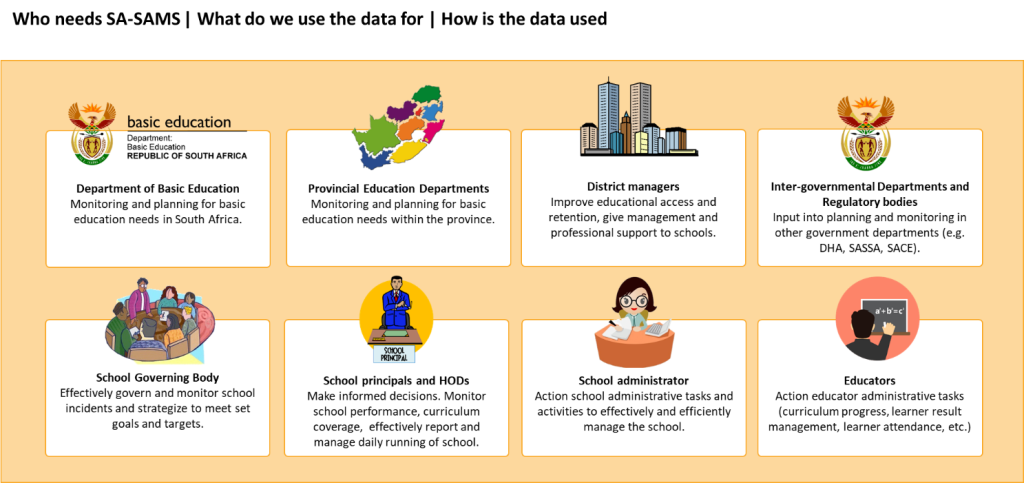
By Mamello Khuto, Riante Narayanan, and Shiloh Naiken
- Introduction
Following the Department of Basic Education (DBE) structure, the Education Management Information System (EMIS) directorate is currently a function and unit within the DBE with the responsibility to develop and maintain an integrated education information system for the management of education. This is achieved through the acquisition, processing, dissemination and reporting of quality education data that is linked to the strategic goals and objectives as identified by the DBE[1].
The DBE owns and supports the South African School Administration and Management System (SA-SAMS), an application that captures and collects this education data. This is a standalone application, with a local database held at each school, which supports all aspects of school administration and management operations in all public schools in South Africa. Given this rather outdated technology, a lengthy labour-intensive process is needed to extract all the schools’ data held in SA-SAMS for management information used at circuit, district, provincial and national levels[2].
Currently, the DBE is engaged in a project to modernise SA-SAMS, which started in 2018 and has to date, appointed the National Education Collaboration Trust (NECT) to implement this project on its behalf.
This paper outlines how the NECT went about with the design and planning process for a new EMIS architecture for the DBE and seeks to – (a) reflect on the design and planning processes of the delivery, and (b) draw useful lessons from this to guide similar future education management information system architecture initiatives.
- Explaining EMIS
According to the United Nations Education, Social, and Cultural Organisation (UNESCO) EMIS is defined as “a system for the collection, integration, processing, maintenance and dissemination of data and information to support decision-making, policy-analysis and formulation, planning, monitoring and management at all levels of an education system”[3]
Based on the above definition, it can be deduced that the primary objective of an EMIS is to support the education sector to arrive at sound decision-making and policy formulation by providing accurate and real-time data. This data, in turn, plays a critical role in supporting education authorities, policymakers, and administrators in planning, monitoring, and evaluating educational programmes and policies for schools.
- Issues with the DBE EMIS Application
Following what was outlined at the start of the paper, the stand-alone SA-SAMS application resulted in key challenges that make the end-to-end process highly inefficient, prone to errors, and led to significant inefficiencies in providing the data that is dependable and timely.
Some of these key challenges include:
- Data is not validated during capturing into SA-SAMS, leading to further quality assurance (QA) issues that need checking at various levels within the DBE and the sector. Once the QA process is completed, the schools are expected once more to recapture data that was incorrect or missing, which can be a laborious exercise.
- There are a lot of manual processes to collect data that is already in SA-SAMS (e.g., templates that are distributed to be completed by schools) as the data is not always available in a timeous manner.
- There is duplication of capture between SA-SAMS and other systems (e.g., PERSAL) which results in misalignment of information in the various systems; and
- Different primary sources for learner data, resulting in the duplication of this data (e.g., Learner Unit Record Information Tracking System (LURITS) number, National Senior Certificate (NSC) number).
In consideration of all the above, there was a need for the EMIS application to be overhauled to deal with these challenges. Taking the assignment from DBE, how did the NECT go about with the planning and design for the new EMIS architecture for the modernisation of SA-SAMS?
- How the NECT planned and designed for the EMIS implementation
Although the current SA-SAMS is rich in functionality and features eighteen (18) school management and administration modules), the user experience is compromised as the functionality lacks integration, systemic flow, and intuitiveness.
To resolve the shortfalls of the current SA-SAMS, the NECT Project Team surveyed the market for a school solution that has as rich functionality as the current SA-SAMS with an enterprise resource planning (ERP) design (a software solution designed to streamline and automate processes within an organization). In short, through the desktop research and the engagement discussion held with the
UNESCO EMIS team, the conclusion is that there was no other school administration system that matched the modernisation functionality for SA-SAMS anywhere in the world as a holistic solution.
Based on the above dilemma, the approach that the Team adopted was to fully understand the developed User Requirement Specification process as developed by the DBE. This was done through analysing both the end-users and the current system to identify requirements that would meet the strategic needs of the sector through the new EMIS delivery.
How did the NECT Project Team achieve that?
- Clear articulation of the EMIS design and scope
In defining the scope and design, the NECT Project Team first aligned the planned delivery of the modernised EMIS to the basic education sector goals as conceptualised in Chapter 9 of the National Development Plan. The principal idea was how to innovate the sector with a future-proofed system that would cover the full value chain of managing a school. This was done through assessing the current SA-SAMS with gold star systems to benchmark against the defined end-user and system requirements for the envisioned transformation. This process, in return, allowed time for the opportunity to research potential vendors and their solutions, in addition to allowing the benchmarking timelines for estimating how long either the customisation, or configuration or development would take to deliver the new EMIS solution.
- Defined the guiding principles for finding best fit EMIS.
Given the fact that the Project Team did not have a full grasp of the envisaged EMIS architecture, they proactively defined the guiding principles that would guide the search for an off-the-shelf solution to modernise SA-SAMS. The guiding principles in EMIS architecture serve as a set of fundamental convictions or values that guide decision-making and shape the overall direction and approach to designing, implementing, and managing IT systems and infrastructure. These principles help ensure consistency, alignment with business goals, and the achievement of desired outcomes.
- Modelling an EMIS application.
The Project Team developed a model of the holistic picture of education management and administration components that is enabled through enterprise solution management which shows the sector value chain (see Figure 1 below). By showing the link or integration between these components, it enabled a comprehensive overview of how the modernised solution will support the education sector which would make it possible for the sector stakeholders to understand the dynamics between different elements and make evidence-based decisions to improve educational outcomes. The DBE accepted this model and it was subsequently used as part of the document used for new EMIS model bidding process.

Figure 1: Education Management Information System
- Defined an enterprise-level impact to the education sector through introduction of Benefit Realisation Assessment
The assessment defined and documented the benefits that would be realised in implementing the modernised EMIS to the Education Sector: schools, educators, school administrators, principals, school governing bodies, provincial departments, and the national department in managing and administrating the education sector effectively and efficiently.

Figure 2: Benefits Realisation Assessment
The most outstanding benefit of this assessment, as shown by Figure 2above, depicted who needed SA-SAMS data, what they would use data for, and how that data was going to be used.
- Mini lessons learnt.
In closing, what has been some of the lessons learnt in this EMIS implementation for the modernisation of SA-SAMS that can be applied in similar initiatives?
- Full understanding of the education sector value chain
Implementation teams need a solid in-depth understanding of the Education Sector and its components, as well as the dependencies between the components, to achieve seamless management of the sector. This is to ensure that all end-user and system requirements are covered in the design and planning of the EMIS solution.
- End-user commitment and buy-in
When developing any system, including EMIS, it is imperative to have total buy-in and commitment from the stakeholders for a successful product delivery, implementation, and adoption. This desired end-state might pose a challenge if there is lack of capacity (people), processes and systems in place to support this (which was a case with the DBE and the provinces). To ensure a smooth transition and implementation, the NECT ushered an inclusive process to elicit the user commitment and buy-in through:
- Multiple stakeholder approach in the form of monthly engagements to appraise the DBE and the provincial education departments of the progress in implementing the new EMIS system.
- A detailed change management approach that entails, user acceptance testing, as well as training the DBE and the provincial education end-users on the new EMIS in the sandpit environment to familiarize themselves with the new functionality.
- Lastly, creating the superuser communities in all the provinces to test the new functionality to ensure that it performs all the management and administration functions that the school requires.
[1] Department of Basic Education – Education Management Information System, www.education.gov.za
[2] Department of Basic Education – SA–SAMS Modernisation User Requirements Specification 2016
[3] UNESCO – Education for All by 2015: will we make it? www.unesco.org


